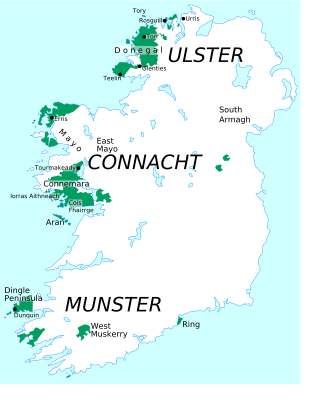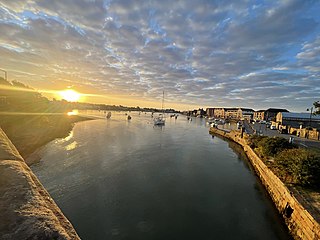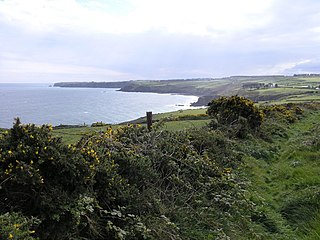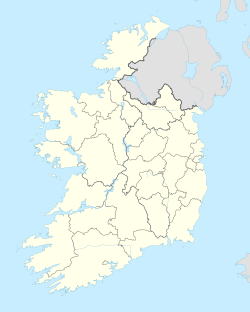
County Waterford is a county in Ireland. It is in the province of Munster and is part of the Southern Region. It is named after the city of Waterford. Waterford City and County Council is the local authority for the county. The population of the county at large, including the city, was 127,363 according to the 2022 census. The county is based on the historic Gaelic territory of the Déise. There is an Irish-speaking area, Gaeltacht na nDéise, in the southwest of the county.

A Gaeltacht is a district of Ireland, either individually or collectively, where the Irish government recognises that the Irish language is the predominant vernacular, or language of the home. The Gaeltacht districts were first officially recognised during the 1920s in the early years of the Irish Free State, following the Gaelic revival, as part of a government policy aimed at restoring the Irish language.

The Iveragh Peninsula is located in County Kerry in Ireland. It is the largest peninsula in southwestern Ireland. A mountain range, the MacGillycuddy's Reeks, lies in the centre of the peninsula. Carrauntoohil, its highest mountain, is also the highest peak in Ireland.

Dungarvan is a coastal town and harbour in County Waterford, on the south-east coast of Ireland. Prior to the merger of Waterford County Council with Waterford City Council in 2014, Dungarvan was the county town and administrative centre of County Waterford. Waterford City and County Council retains administrative offices in the town. The town is in a townland and civil parish of the same name.

Baile an Fheirtéaraigh unofficially anglicised as Ballyferriter, or also known as An Buailtín, is a Gaeltacht village in County Kerry, Ireland. It is in the west of the Corca Dhuibhne (Dingle) peninsula and according to the 2002 census, about 75% of the town's population speak the Irish language on a daily basis. The village is named after the Norman-Irish Feiritéar family who settled in Ard na Caithne in the late medieval period. The last Chief of the Name was the seventeenth-century Bard and leader Piaras Feiritéar who was executed. The older Irish name for the village An B[h]uailtín is still used locally.

Údarás na Gaeltachta, abbreviated UnaG, is a regional state agency which is responsible for the economic, social and cultural development of Irish-speaking (Gaeltacht) regions of Ireland. Its stated purpose is to strengthen the Gaeltacht communities, to increase the quality of life of its community members and facilitate the preservation and extension of the Irish language as the principal language of the region. It gives funding to small local businesses that have to compete with foreign companies.

Furbo or Furbogh is a settlement in Connemara, County Galway, Ireland. As of the 2022 census, it had a population of 868 people. It lies along the coast, overlooking Galway Bay, in a Gaeltacht area.

Munster Irish is the dialect of the Irish language spoken in the province of Munster. Gaeltacht regions in Munster are found in the Gaeltachtaí of the Dingle Peninsula in west County Kerry, in the Iveragh Peninsula in south Kerry, in Cape Clear Island off the coast of west County Cork, in Muskerry West; Cúil Aodha, Ballingeary, Ballyvourney, Kilnamartyra, and Renaree of central County Cork; and in an Rinn and an Sean Phobal in Gaeltacht na nDéise in west County Waterford.
Coimisiún na Gaeltachta, abbreviated CnaG, was an Irish government agency which worked from 2000 to 2002 to draft recommendations to strengthen the role of the Irish language in the Gaeltacht, the Irish-language-speaking area of Ireland. It was established at the instigation of Éamon Ó Cuív, the then Minister of State at the Department of Arts, Heritage, Gaeltacht and the Islands and its work completed under the guidance of his successor, Mary Coughlan. The Irish Government approved the publication of the Commission's report, without commitment.

Ring or Ringagonagh is a parish within the Irish-speaking Gaeltacht na nDéise area in County Waterford, Ireland. It lies on a peninsula about eleven kilometres (7 mi) south of Dungarvan. The main settlement is the village of Ring or Ringville, which is within the townland of Ballynagaul.
Gluaiseacht Cearta Sibhialta na Gaeltachta or Coiste Cearta Síbialta na Gaeilge, was a pressure group campaigning for social, economic and cultural rights for native-speakers of Irish living in Gaeltacht areas. It was founded in Connemara in 1969 to highlight the decline of the Irish language and to campaign for greater rights for Irish speaking areas in the area of access to services, broadcasting and ultimately an elected assembly of their own. It was later named Gluaiseacht na Gaeltachta.
Rinn Ó gCuanach CLG is a Gaelic Athletic Association club based in the Irish speaking (Gaeltacht) area of Ring, County Waterford, Ireland. The club fields teams of both GAA codes, including two adult Gaelic football teams and two adult hurling teams in the Waterford County Championships. It is one of a small number of dual clubs at senior level in the county, competing in the Senior Hurling and Senior Football championships. The club's second string teams take part in the Waterford Junior Hurling and Football championships.

Old Parish is a village in west County Waterford, Ireland. It is part of the Gaeltacht in Waterford Gaeltacht na nDéise.
A Neo-Gaeltacht is an area where Irish has a strong presence as a spoken language but is not part of the officially defined or traditional Gaeltacht areas. It has been argued that non-Gaeltacht activist groups wishing to establish an Irish language community need to show that it is large, permanent and formally organised and that it has a growing number of people using Irish as their first language. Another objective is a situation in which children use Irish among themselves and with other Irish speakers in a natural way while being able to deal with a largely English-speaking world.
A naíonra is an Irish medium playgroup for pre-school children, which follows the principle of Total Early Immersion.

Baile Ghib is a small village and Gaeltacht in County Meath, Ireland. It is about 70km northwest of Dublin city. Local Link bus route 186 was introduced in October 2024 and links the area several times daily to Kells and other villages in Meath & Cavan.

Cois Fharraige, previously spelled Cois Fhairrge, is a coastal area west of Galway city, where the Irish language is the predominant language. It stretches from Na Forbacha, Bearna, An Spidéal to Indreabhán. There are between 8,000 and 9,000 people living in this area.

Ballynagaul is a Gaeltacht area within the Irish-speaking Gaeltacht na nDéise part of County Waterford. Comprising the townlands of Baile na nGall Mór and Baile na nGall Beag, it is located approximately 9.6 kilometres southeast of Dungarvan. The village of Ring is located in the area.

The Gaeltacht Act 2012 is an Act of the Oireachtas of Ireland. The Act redefined the traditional Irish-speaking areas or Gaeltacht in the Republic of Ireland on linguistic criteria instead of on geographic areas which had been the position until 2012. While the traditional Gaeltacht boundaries still exist the Act sets out ways where areas outside the Gaeltacht can be formally designated as Irish Language Networks and Gaeltacht Service Towns.

A Gaeltacht Service Town is an area designated under the Gaeltacht Act 2012, situated in or adjacent to Gaeltacht areas in Ireland, that have a population of over 1,000 people, and which play a significant role in providing public services, recreational and commercial facilities for Gaeltacht residents.


















